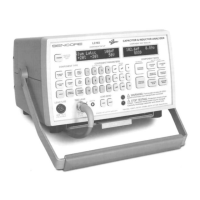42
A few flybacks used in some small solid state chassis
have a low impedance primary which will not ring when
good. However, these flybacks will always have a
secondary winding which will ring good if the
transformer is good. Simply ring the secondary
windings. If one rings good the flyback does not have
any shorted turns. If no winding rings good the flyback
is bad.
A winding in the secondary of a flyback may
occasionally open, rather than short. An open winding
will not load the other windings as a short does. If the
operation of the chassis indicates the possibility of an
open winding, leave the LC103 connected to the primary
winding and short each of the windings with a jumper.
Shorting out a winding will reflect back to the primary
and cause the ring test to go from “GOOD” to “BAD.” If
the ring test does not change, the winding being shorted
with the jumper is open.
———————— WARNING —————————
Do not connect the LC103 to the yoke a flyback in-
circuit until all power to the chassis has been
removed, and the AC line cord has been
disconnected.
———————— ATTENTION ————————
Ne pas connecter la sonde du LC103 à un
transformateur en circuit avant de vous assurer que
le chässis n’est plus sous tension et que le cordon
secteur est déconnecté.
To ring a flyback transformer:
1. Connect the test leads or probe across the primary
winding of the flyback.
2. If the filament is powered by a scan derived supply
disconnect the CRT socket board from the CRT to
prevent the filaments from loading the secondary
and giving a false ringing indication.
3. Press and hold the INDUCTOR RINGER test button.
If the LC103 display reads “GOOD” the flyback is
good, and the remaining steps are not necessary. A
“BAD” reading indicates that either the flyback has
a shorted turn or that it is being loaded down. The
following steps will locate the defect. Continue
disconnecting the loads in the following order until
the flyback rings “GOOD.”
1. B+ supply
2. Horizontal yoke
3. Damper diode
4. H.O.T. collector
5. Scan derived supplies
4. If the flyback rings “GOOD” after you disconnect a
load, the flyback does not have a shorted turn. If the
flyback rings “GOOD” after disconnecting a scan
derived supply, double check the components in that
supply to make sure none of them are shorted or
leaky.
5. If all the loads are disconnected and the ringing test
still indicates BAD, completely remove it from the
circuit. If the flyback primary still rings less than 10,
the flyback has a shorted turn and must be replaced.
Leakage Testing Flyback Transformers
In some cases, a flyback may develop a short or leakage
from one winding to another or between a winding and
the core or mounting bracket. Such a leakage path will
often pull down the B+ supply. Sometimes this will be a
zero resistance short that can be found with an
ohmmeter, but many times the leakage only occurs when
a higher voltage is applied. If the flyback passes the
Ringer Test and you suspect possible leakage (the
chassis draws excessive current, blows H.O.T.s, or shuts
down) check the flyback using the LC103’s LEAKAGE
function. You should measure no leakage between
separate windings or between any winding and the core
or mounting bracket with 1000 volts applied. When
checking an IHVT for leakage use both polarities of
voltage to make sure the leakage path does not involve a
diode.
NOTE: Leakage between windings is different than a
shorted turn. A Hi Pot test is needed to find leakage
between windings. The Ringer test will find the more
common shorted turn but will not find leakage or shorts
between windings.
To perform the flyback leakage test:
1. Completely remove the flyback from the chassis.
2. Connect the test leads across two separate windings.
3. Enter 1000 volts into the LC103.
NOTE: You can select any type of capacitor or no
component at all.
4. Press and hold the LEAKAGE button and read the
amount of leakage. It should drop to 0.0 uA. If the
current does not drop to 0.0 uA the flyback is bad and
should be replaced.
5. Repeat steps 3-5 for all combinations of windings.
Many flybacks have the high voltage rectifier diodes
(tripler) built into the secondary winding. These flybacks
are called Integrated High Voltage Transformers
(IHVTs). The Ringing test will locate defective turns in
these types of flybacks as well. A problem with the
diodes will result in problems with the high voltage,
even though the Ringing test indicates “GOOD”. If the
flyback rings “GOOD” but produces no high voltage,
one of the diodes is open. If the high voltage is several
thousand volts too low and the flyback rings good, one
or more of the diodes is shorted. In either case the
flyback is defective and must be replaced.

